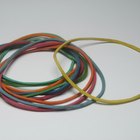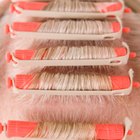While it is possible to put long hair into a low ponytail with one hand using a normal elastic, it is much easier when using an elastic specially made for this purpose, which can be purchased online or easily and inexpensively made.
The Usual Way
If your hair is reasonably manageable and you have full hand dexterity, it is possible, though difficult, to put in a low ponytail with one hand using a standard elastic. Comb or brush back your hair and gather it at the nape of your neck as much as possible. Stretch the elastic around all your fingers and thumb, and grasp your hair with the ends of your fingers. Flex your fingers and thumb to pull your hair through, keeping the elastic as close to the neck as possible. Once the hair is threaded through the ponytail once, twist it to form a new loop as usual, and repeat. To increase tightness, grasp ponytail below the elastic with all fingers and use index and middle fingers to scoot the elastic up toward the head.
The first twist is the most difficult, as you have to maintain the first loop while forming a new one. This is easiest if your hair is long enough for you to lean against a wall and pin it. It is somewhat easier if the twist is underneath the hair, so that you can pin the elastic between a finger and your neck. A second twist is much easier.
One-Handed Ponytail Device
A ponytail elastic intended for one-handed use was invented by Sara Uhrig, an occupational therapist, and announced in the "Journal of Hand Therapy" in March of 1996. It consists of a knotted loop of elastic about the same size as a normal ponytail elastic, but with a bead held on by the knot. Getting the loop around your hair in the first place uses the same technique as a standard elastic, but instead of twisting to form the second loop, you pull the knot away from the bead to pull the elastic into a figure-8 with the bead holding the initial loop closed. You then wrap the second loop around the ponytail.
A disadvantage of this device is that it still depends on your ability to gather all your hair one-handed. This can make a high ponytail difficult. Its main advantage is that it removes the difficult twist from the process.
The 1-Up
A more recent invention makes ponytail variations much easier to achieve with one hand. Invented by Holly Franklin, an upper-arm amputee, the 1-Up is used much more like a headband that you can tighten rather than a standard ponytail elastic. This device consists of a long string of elastic strung through a toggle to make a loop.
To use a 1-Up, you drape it around your neck like a necklace, then lift it to headband height and tighten, then secure one end to a partial limb or by standing on it, and pull the loop closed, guiding it with your hand. The elastic both gathers and secures the ponytail, making it much easier to achieve high ponytails. Once the ponytail is gathered, you wrap the trailing elastic tightly around the ponytail to secure it.
The main disadvantage of a 1-Up is that you need either a partial limb or some other way of securing the pulled end. Advantages include removing the grab-and scoot portion of the process entirely, an easier way to make high ponytails, and the fact that the elastic is long enough to be used as a headband.
Related Articles

Fast Messy Bun Hairstyles With an ...

How to Braid in Fake Hair

How to Tighten a Tie Knot

How to Use Sponge Rollers to Make ...

How to Put Dreads in a Bun

How to Do Tight Braids

How to Hold Braids Without Rubber Bands

How to Make a Grecian Braid

How to Tie a Baptism Bonnet

1965 Hairstyles

How to Do Temporary Dreads

How to Make a Hand-Tied Weft Using Bulk ...

How to Do Two Strand Twists With ...

How to Put Rubber Bands in Your Goatee

How to Use Velcro Rollers So They Don't ...

How to Do a Quick Weave Ponytail

How to Do a Rubber Band Hair Weave

Types of Perm Rods

Facial Hairstyles in the 1960s

Tips to Keep Your Hair Not Knotty at ...
References